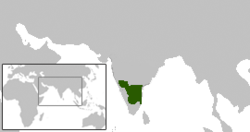Pallava dynasty
| Pallava Empire | ||||||||||||
| Dynasty | ||||||||||||
|
||||||||||||
|
Pallava territories during Narasimhavarman I c. 645. This includes the Chalukya territories occupied by the Pallavas.
|
||||||||||||
| Capital | Kanchipuram | |||||||||||
| Languages | Tamil, Sanskrit, Prakrit | |||||||||||
| Religion | Hinduism | |||||||||||
| Government | Monarchy | |||||||||||
| King | ||||||||||||
| • | 275–300 | Simhavarman I | ||||||||||
| • | 882–897 | Aparajitavarman | ||||||||||
| Historical era | Classical India | |||||||||||
| • | Established | 275 CE | ||||||||||
| • | Disestablished | 897 CE | ||||||||||
|
||||||||||||
| Today part of |
|
|||||||||||
| Pallava Kings (200s–800s) | |
| Vishnugopa II | |
| Simhavarman III | |
| Simhavishnu | |
| Mahendravarman I | (600-630) |
| Narasimhavarman I | (630–668) |
| Mahendravarman II | (668–670) |
| Paramesvaravarman I | (670–695) |
| Narasimhavarman II | (700-728) |
| Paramesvaravarman II | (728–731) |
| Nandivarman II | (731–795) |
| Dantivarman | (795–846) |
| Nandivarman III | (846-869) |
| Aparajitavarman | (880-897) |
|
Aditya I (Chola Empire) |
(870-907) |
The Pallava dynasty was a South Indian dynasty that existed from 275 CE to 897 CE, ruling a portion of what is today southern India. They gained prominence after the eclipse of the Satavahana dynasty, whom the Pallavas served as feudatories.
Pallavas became a major power during the reign of Mahendravarman I (571 – 630 CE) and Narasimhavarman I (630 – 668 CE) and dominated the Telugu and northern parts of the Tamil region for about 600 years until the end of the 9th century. Throughout their reign they were in constant conflict with both Chalukyas of Badami in the north and the Tamil kingdoms of Chola and Pandyas in the south and were finally defeated by the Chola kings in the 9th century CE.
Pallavas are most noted for their patronage of architecture, the finest example being the Shore Temple, a UNESCO World Heritage Site in Mahabalipuram. The Pallavas, who left behind magnificent sculptures and temples, established the foundations of medieval South Indian architecture. They developed the Pallava script from which Grantha ultimately descended. The Pallava script gave rise to several other southeast Asian scripts. Chinese traveller Hiuen Tsang visited Kanchipuram during Pallava rule and extolled their benign rule.
A Sangam Period classic, Manimekalai, attributes the origin of the first Pallava King from a liaison between the daughter of a Naga king of Manipallava named Pilli Valai (Pilivalai) with a Chola king, Killivalavan, out of which union was born a prince, who was lost in ship wreck and found with a twig (pallava) of Cephalandra Indica (Tondai) around his ankle and hence named Tondai-man. Another version states that "Pallava" was born from the union of the Brahmin Ashvatthama with a Naga Princess also supposedly supported in the sixth verse of the Bahur plates which states "From Ashvatthama was born the king named Pallava". The Pallavas themselves claimed to descend from Brahma and Ashvatthama.
...
Wikipedia

